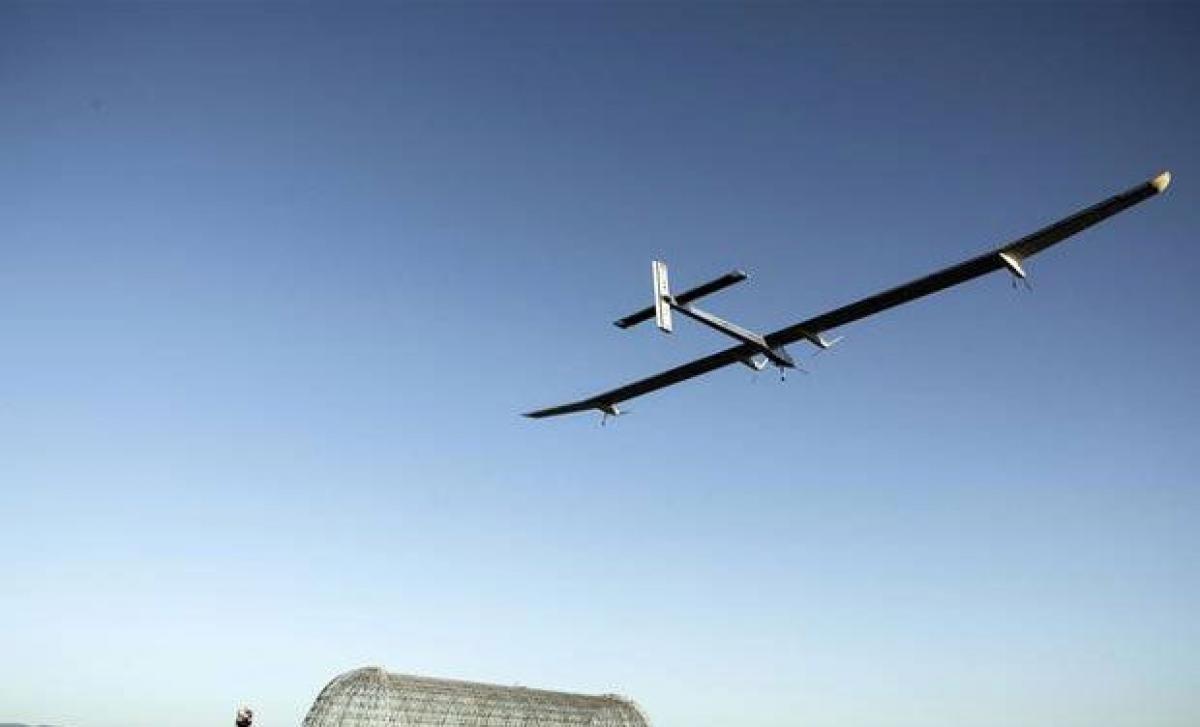Live
- Chiranjeevi Visits Allu Arjun’s Residence Amid Legal Turmoil
- Over 1.1 million Syrians homeless since recent escalation of hostilities: UN
- NBA’s 'commitment to constant innovation' in Covid chaos led to the birth of in-season tournament
- SC issues notice on PIL for conducting public awareness campaign on snake bites
- Varun Dhawan Becomes First from Film Fraternity to Support Allu Arjun
- Mohan Babu Faces Setback as Court Rejects Bail in Journalist Attack Case
- After suspension, ex-registrar of iconic university in Bengal dismissed from job
- Passenger vehicles clock highest ever November sales in India
- K'taka BJP MLAs stage walkout from Assembly for not allowing discussion on Waqf row
- Mohan Yadav inaugurates MP's 8th Ratapani Tiger Reserve
Just In

x
Highlights
The revolutionary Solar Impulse 2 aircraft flew out of central Japan on Monday heading for Hawaii, the most ambitious leg of its quest to circumnavigate the globe powered only by the sun. Swiss pilot Andre Borschberg, 62, left the ground in the city of Nagoya around 3:00 am (1800 GMT); five days after weather problems forced the organisers to cancel an earlier attempt. \"It took off at 3 o\'clock and 4 minutes,\" spokeswoman Elke Neumann said.
The revolutionary Solar Impulse 2 aircraft flew out of central Japan on Monday heading for Hawaii, the most ambitious leg of its quest to circumnavigate the globe powered only by the sun. Swiss pilot Andre Borschberg, 62, left the ground in the city of Nagoya around 3:00 am (1800 GMT); five days after weather problems forced the organisers to cancel an earlier attempt. "It took off at 3 o'clock and 4 minutes," spokeswoman Elke Neumann said.
.jpg)
Hours later, she told AFP that the high-tech plane remained in the air, although it might still come back "because it has not reached a point of no return yet". That will be the moment at which Solar Impulse is committed to attempt the Pacific Ocean crossing and will not be able to get back to Japan. "We'll have that information around 11:30 am local time (0230 GMT)," she said. The journey to Hawaii is 7,900 kilometres (4,900 miles) and is expected to last at least five days and five nights.
It is the eighth leg of the circumnavigation, and with nowhere to land after leaving Japan, is considered the riskiest so far. Borschberg has said he will keep in shape during his long solo flight by doing yoga, and will sleep 20 minutes at a time, normally at night. But he has also previously admitted that being cooped up in the 3.8-cubic-metre (130-cubic-foot) cockpit for long stretches of time is a challenge.
Weather window
Solar Impulse 2 set off from Abu Dhabi earlier this year in a multi-leg attempt to get all the way around the world without a single drop of fuel. The featherweight flying machine was not supposed to land in Japan, but bad weather en route from Nanjing in China to Hawaii forced a diversion at the start of June.
The plane has since been stranded in Japan for nearly a month, with the crew scouring long-range forecasts for a favourable weather window. A chance to restart the record-breaking journey presented itself last week, with the plane due to leave Nagoya early Wednesday, but mission chiefs pulled the plug at the 11th hour due to bad weather over the Pacific Ocean. Neumann said the weather looked good for now but could still change. In an interview published Thursday, one of the plane's two pilots, Bertrand Piccard, said it must cross the Pacific within a few weeks or it could remain stuck in Japan for a year.
By early August, the days will become too short for the solar-driven plane to cross the Pacific, and subsequently the Atlantic Ocean safely, he told the Tribune de Geneve daily. Solar Impulse 2 has 17,000 solar cells and on-board rechargeable batteries. Its top speed is 140 kilometres an hour. Its wingspan is longer than that of a jumbo jet, but it weighs only 2.3 tonnes -- about the same as a car. The plane is the successor to Solar Impulse, which managed a 26-hour flight in 2010, proving its ability to store enough power in lithium batteries during the day to keep flying at night. Ridiculed by the aviation industry when it was first unveiled, the venture has since been hailed around the world, including by UN chief Ban Ki-moon.

Next Story
More Stories
ADVERTISEMENT
© 2024 Hyderabad Media House Limited/The Hans India. All rights reserved. Powered by hocalwire.com







